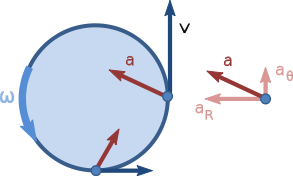- Non-uniform circular motion
-
Non-uniform circular motion is any case in which an object moving in a circular path has a varying speed. Some examples of non-uniform circular motion include a roller coaster, a vertical pendulum, and a car riding over a hill. All of these situations include an object traveling at different speeds in a circular path. For the roller coaster, its cars travel faster during its trip down than its trip up. The pendulum’s mass swings in a semicircle in which its trip up slows down to 0 m/s and comes back down. A car riding over a hill will experience different speeds at different points of the hill.
Contents
Differences from uniform circular motion
The way to express non-uniform circular motion is not that different from the techniques used in calculating uniform circular motion. In uniform circular motion, the magnitude of the tangential acceleration is always equal to zero assuming speed remains constant. The radial acceleration in uniform circular motion is equal to the centripetal acceleration, which is
 towards the center of the circle. In non-uniform circular motion, the radial acceleration is the same and equal to
towards the center of the circle. In non-uniform circular motion, the radial acceleration is the same and equal to  towards the center of the circle. What is different is the tangential acceleration, since speed is non-zero and changing.
towards the center of the circle. What is different is the tangential acceleration, since speed is non-zero and changing.Since there is a non-zero tangential acceleration, there are forces that act on an object in addition to its centripetal force (composed of the mass and radial acceleration). These forces on the object include forces such as weight, normal force, and other forces acted on the object due to the environment it is in such as friction.
Important facts
An interesting characteristic of the additional forces that non-uniform circular motion takes into account is that they do not always follow traditional force concepts. For example, in many situations weight is countered by its normal force. When weight points down, normal force points up. In non-uniform circular motion, normal force does not always point in the opposite direction of weight. Here is an example with an object traveling in a straight path then loops a loop back into a straight path again.
This diagram shows the normal force pointing in other directions rather than opposite to the weight force. The normal force is actually the sum of the radial and tangential forces that help to counteract the weight force and contribute to the centripetal force. The normal force can be broken down into horizontal and vertical components such as in the diagram to the right.
From this diagram, the horizontal component of normal force is what contributes to the centripetal force. The vertical component of the normal force is what counteracts the weight force of the object.
One characteristic that is in non-uniform circular motion that may seem illogical is the fact that normal force and weight can point in the same direction. Both forces can point down, yet the object will remain in a circular path without falling straight down. First let’s see why normal force can point down in the first place. In the first diagram, let's say the object is a person sitting inside a plane, the two forces point down only when it reaches the top of the circle. The reason for this is that the normal force is the sum of the weight and centripetal force. Since both weight and centripetal force points down at the top of the circle, normal force will point down as well. From a logical standpoint, a person who is traveling in the plane will be upside down at the top of the circle. At that moment, the person’s seat is actually pushing down on the person, which is the normal force.
The reason why the object does not fall down when subjected to only downward forces is a simple one. Think about what keeps an object up after it is thrown. Once an object is thrown into the air, there is only the downward force of earth’s gravity that acts on the object. That does not mean that once an object is thrown in the air, it will fall instantly. What keeps that object up in the air is its velocity. The first of Newton's laws of motion states that an object’s inertia keeps it in motion, and since the object in the air has a velocity, it will tend to keep moving in that direction.
Applications involving non-uniform circular motion
Solving applications dealing with non-uniform circular motion involves force analysis. With uniform circular motion, the only force acting upon an object traveling in a circle is the centripetal force. In non-uniform circular motion, there are additional forces acting on the object due to a non-zero tangential acceleration. Although there are additional forces acting upon the object, the sum of all the forces acting on the object will have to equal to the centripetal force.




Notice that radial acceleration is used when calculating the total force. Tangential acceleration is not used in calculating total force because it is not responsible for keeping the object in a circular path. The only acceleration responsible for keeping an object moving in a circle is the radial acceleration. Also, keep in mind that since the sum of all forces is equal to the centripetal force, drawing centripetal force into a free body diagram is not necessary and usually not recommended.
Using
 , we can draw free body diagrams to list all the forces acting on an object then set it equal to
, we can draw free body diagrams to list all the forces acting on an object then set it equal to  . Afterwards, we can solve for what ever is unknown (this can be mass, velocity, radius of curvature, coefficient of friction, normal force, etc.). For example, the visual above showing an object at the top of a semicircle would be expressed as
. Afterwards, we can solve for what ever is unknown (this can be mass, velocity, radius of curvature, coefficient of friction, normal force, etc.). For example, the visual above showing an object at the top of a semicircle would be expressed as  .
.In uniform circular motion, total acceleration of an object in a circular path is equal to the radial acceleration. Due to the presence of tangential acceleration in non uniform circular motion, that does not hold true any more. To find the total acceleration of an object in non uniform circular, find the vector sum of the tangential acceleration and the radial acceleration.

Radial acceleration is always equal to
 . The tangential acceleration is simply the derivative of the velocity at the given point.
. The tangential acceleration is simply the derivative of the velocity at the given point.
See also
Categories:
Wikimedia Foundation. 2010.





